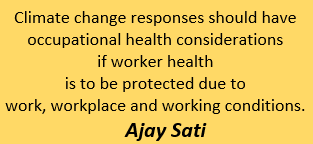On Monday, 22nd April 2024, a UN research issued a warning that over 2.4 billion workers will be exposed to extreme heat at workplaces due to climate change which will affect more than 70% of world’s workers.
Back home, in India, a prominent politician and a Union Minister, Nitin Gadkari collapsed on 24th April during an election campaign where the temperature reached 38 degrees C. He felt dizzy after getting up on the dais to address an election rally; his security guards rushed and gave him swift medical assistance which is usually not available to an ordinary outdoor worker. The Minister while addressing the gathering said, ‘The AC of my helicopter was not working. When I reached the crowded venue, the temperature was high and ventilation low due to which I felt uneasy. But I recovered within minutes. I am alright now.’
Extreme heat not only causes discomfort but also leads to productivity losses. In vulnerable population, extreme heat causes death.
The UN report states that an estimated 18,970 lives are lost each year due to occupational injuries attributable to excessive heat, and more than 26.2 million people are living with chronic kidney disease related to workplace heat stress.
In addition, each year air pollution kills over 860,000 outdoor workers. Solar UV radiation also causes over 19,000 deaths from non-melanoma skin cancer.
As temperatures rise, heart ailments are also increasing.
Last week, a 26 years old man died from heat-related illness while working in a sugarcane field in Belle Glade, Florida when temperatures rose to 36 plus degree Centigrade. The Department of Labor blamed the contractor for failing to provide the worker with proper protection. OSHA’s area director in Fort Lauderdale, Condell Eastmond, said in reference to this fatality, ‘This young man’s life ended on his first day on job because his employer did not fulfil its duty to protect employees from heat exposure, a known and increasingly dangerous hazard.’
Of the many lessons to be learnt when people die or faint in extreme heat conditions is to seek Occupational Health advice for at least one reason – that it has the ability to prevent catastrophic events proactively.
The future of outdoor work in extreme hot climate is a matter of concern; and the world has to work now, collectively.
According to the Department of Labour, from 1992 to 2021, exposure to ambient heat caused deaths of 999 US workers, or 33 fatalities per year. However, the FDA noted that the data for illnesses, injuries, and deaths attributable to heat-associated occupational diseases are probably ‘vast underestimates.’ A similar observation was echoed by Harvard physician and historian, David S Jones.
In an earlier article ‘The future of work in extreme heat’, in The Occupationist, I have mentioned deaths in tropical countries are mainly due to lack of timely awareness, lack of shade areas, lack of cool, potable drinking water and lack of timely government advisory.
Greenhouse emissions are directly related to population growth as uncontrolled population leads to increase in consumption.
Extreme heat not only causes discomfort but also leads to productivity losses. In vulnerable population, extreme heat causes death.
In India, by around 2100, it is estimated that 1.5 million more people will likely die every year as a result of climate change; this is as high as deaths from all infectious diseases in India today. This was revealed in an October 2019 study by the Climate Impact Lab.
Are we prepared? Are we preparing?
The future of outdoor work in extreme hot climate is a matter of concern; and the world has to work now, collectively. Governments and industry leaders should make every effort to curb greenhouse gas emissions. On the other hand, scientists, researchers and Occupational Health physicians should constantly remind the law makers, industry leaders and the public to be aware of this stark reality and take appropriate actions.
Climate change responses should have occupational health considerations if worker health is to be protected due to work, workplace and working conditions.
Greenhouse emissions are directly related to population growth as uncontrolled population leads to increase in consumption.
To mitigate the issue of productivity loss and health effects of extreme heat (death, discomfort, safety issues), a multi-pronged approach is needed that includes population control, mechanization of agriculture and construction, awareness in all sections of society and timely advisories by the government about the steps to be taken to manage health effects due to heat.
Being a problem that needs multi-pronged solution, time has come when governments globally should work closely with the OH physicians too as they have the experience of creating awareness in the industry and issuing timely advisories (related to not just extreme heat but other relevant health issues) to the employees. Governments must also follow WHO and UN guidance on worker health issues.
Of the many lessons to be learnt when people die or faint in extreme heat conditions is to seek Occupational Health advice for at least one reason – that it has the ability to prevent catastrophic events proactively.
Meanwhile, few things that employers and governments can do to beat the heat are:
- Be aware that extreme heat can kill
- Release heat advisories in advance
- Sensitize the senior management about effect of heat on health, safety and performance
- Ensure senior management sensitizes the site managers
- Conduct separate sessions on effects of heat for site managers and workers expected to be supervising or working out in the sun
- Have shade areas for workers to rest for 10 minutes after 45 to 60 minutes of working in the sun or hot areas
- Provide clean and cool potable water and encourage workers to drink during the 10-minute break
- Provide ablution facilities as otherwise workers avoid drinking enough water which in turn leads to dehydration
- Maintain high level of preparedness to deal with any heat-related health effects (keep ambulance(s) close by)
- Keep outdoor works or election rallies for cooler parts of the day
- Make sure workers and people don’t go outdoors during a heat-wave forecast
- Avoid foods that produce heat in the body (onion, garlic, ginger, black pepper, tea, coffee etc.)
Climate change responses should have occupational health considerations if worker health is to be protected due to work, workplace and working conditions.
To know more, contact
____________________________________________________________________________________________
Dr Ajay Sati is an Occupational Health physician who prefers to describe himself as an Occupationist, to denote, ‘an expert in diseases and other concerns of occupations.’ Dr Sati has managed health and wellness programs in industries he worked, like the atomic energy, and energy (oil & gas) in India and overseas. An experienced virtual consultation expert he was involved in many greenfield and brownfield projects providing inputs from health point of view.



